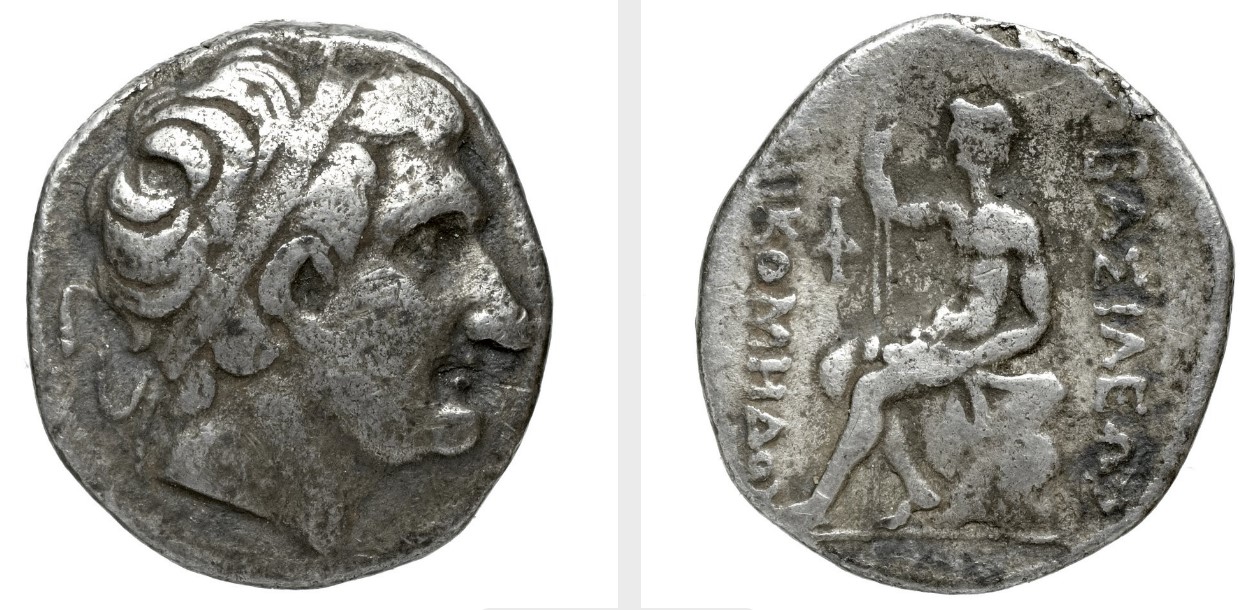Nicomedia (Nicomedes I), silver, drachms (264-255 BCE)
From SILVER
264 BCE - 255 BCE Silver 89 kg
Description
| ObverseInscription or printing placed on the obverse.: | Diademed head right |
| ReverseInscription or printing placed on the reverse.: | ΒΑΣΙΛΕΩΣ / ΝΙΚΟΜΕΔΟΥ (Greek).Warrior goddess (Thracian Bendis?) seated l. upon rock, holding spear and sword in its scabbard, a shield at her feet and behind, the stump of a tree. In outer l. field, Nike and in inner l. field, monogram |
Mint and issuing power
| MintIdentifies the place of manufacture or issue of a numismatic object.: | Nicomedia | Ancient regionAncient region.: | Bithynia | Modern countryModern country: Turkey | AuthorityIdentifies the issuing power. The authority can be "pretended" when the name or the portrait of X is on the coin but he/she was not the issuing power. It can also be "uncertain" when there is no mention of X on the coin but he/she was the issuing power according to the historical sources: | Kingdom of Bithynia (late 4th c.-74 BC), Nicomedes I of Bithynia (king of Bithynia, c. 278-255 BC) |
Chronology
| FromIdentifies the initial date in a range assigned in a numismatic context. | 264 BCE | toIdentifies the final date in a range assigned in a numismatic context.. | 255 BCE | PeriodTime period of the numismatic object.: Hellenistic 323-30 BC |
Physical description
| MetalThe physical material (usually metal) from which an object is made.: | Silver |
Median weightMedian of the weights of numismatic objects (in grams). in grams | 3.80 | DenominationTerm indicating the value of a numismatic object. Examples: tetradrachm, chalkous, denarius.: | drachma |
StandardStandard.: | Attic |
Image

S 1558 - Nicomedia (Nicomedes I), silver, drachms (264-255 BCE).jpg [1]
References
| Die study referencePublication of the study: | Dowler 20211Dowler 2021, p. 158 | ||
| Coin series referenceReference to coin series study: | Sear II2Sear II, n° 7256, HGC 73HGC 7, n° 607 | ||
| Coin series web referenceCoin series web references: | |||
Obverse dies distribution
| FrequencyFrequency of specimen in distribution. ᵖ | Number of obversesNumber of obverse dies. ᵖ (o) | % (o) | Number of coinsNumber of coins. (n) | % (n) | Die nameName(s) of the die(s). |
| 4 | 1 | 100 | 4 | 100 | 1 |
| Total | 1 of 1 | 100 | 4 of 4 | 100 |
Reverse dies distribution
no distribution is available
Quantification
| Number of obversesNumber of obverse dies. ᵖ (o) | 1 | Number of singletons (o1)The number of singleton coins. ᵖ | |
| Number of reverse diesNumber of reverse dies. (r) | 2 | Number of coinsNumber of coins. (n) | 4 |
| Coins per obverse dieNumber of coins per obverse die. (n/o) | 4 | Coins per reverse dieNumber of coins per reverse die. (n/r) | 2 |
| Reverse per obverse ratioRatio of obverse dies divided by reverse dies. (r/o) | 2 | Percentage of singletons (o1)number of coins (n) divided by the number of singletons (o1) ᵖ | % |
| Original number of dies (O) (Carter 1983 formula)The estimation of the number of coins according to Carter 1983 ᵖ | 1.17 | Coins struck if 20,000 as average productivity per dieCoins made if the average productivity for obverses (according to Carter) is 20,000. ᵖ | 23,400 |
| Original number of dies (O) (Esty 2011 formula)The estimation of the number of coins according to the singleton formula in Esty 2011 ᵖ (O) | 1.33 | Survival rate if 20,000 as average productivity per dieSurvival rate if average productivity is 20,000. ᵖ | 0.00017 |
| Coverage (o = % of O) (Esty 1984 formula)Esty 1984 - coverage (% of O) ᵖ (o = % of O) | % | Die productivity if survival rate 1/2,000Average productivity if survival rate is 1/2,000. ᵖ | 6,837.61 |
| Weight of silver (in kg) if 20,000 coins per die (O = Carter formula)Carter 1983 * Median weight * 20000 (*10 if gold or electrum) ᵖ | 89 kg <br /> 89 kg | Die productivity if survival rate 1/5,000Average productivity if survival rate is 1/5,000. ᵖ | 17,094.02 |
Remarks
Most likely one single workstation Likely military